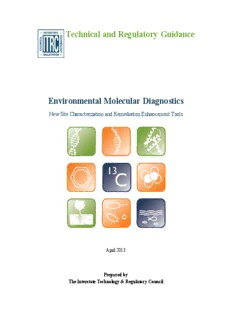
Environmental Molecular Diagnostics - Alaska Department of PDF
Preview Environmental Molecular Diagnostics - Alaska Department of
Technical and Regulatory Guidance Environmental Molecular Diagnostics New Site Characterization and Remediation Enhancement Tools April2013 Prepared by TheInterstateTechnology&RegulatoryCouncil EnvironmentalMolecularDiagnosticsTeam ABOUT ITRC TheInterstateTechnology and Regulatory Council (ITRC) isapublic-privatecoalition working to reducebar- riersto theuseof innovativeenvironmental technologiesand approachesso that compliancecostsarereduced and cleanup efficacy ismaximized.ITRCproducesdocumentsand training that broaden and deepen technical knowledgeand expeditequality regulatory decision making whileprotecting human health and theenvir- onment.With privateand publicsector membersfrom all 50 statesand theDistrict of Columbia,ITRCtruly providesanational perspective.Moreinformation on ITRCisavailableat www.itrcweb.org. ITRCisapro- gram of theEnvironmental Research Instituteof theStates(ERIS),a501(c)(3) organization incorporated in theDistrict of Columbiaand managed by theEnvironmental Council of theStates(ECOS).ECOS isthe national,nonprofit,nonpartisan association representing thestateand territorial environmental commissioners. Itsmission isto serveasachampion for states; to provideaclearinghouseof information for stateenvir- onmental commissioners; to promotecoordination in environmental management; and to articulatestatepos- itionson environmental issuesto Congress,federal agencies,and thepublic. DISCLAIMER Thismaterial wasprepared asan account of work sponsored by an agency of theUnited StatesGovernment. Neither theUnited StatesGovernment nor any agency thereof,nor any of their employees,makesany war- ranty,expressor implied,or assumesany legal liability or responsibility for theaccuracy,completeness,or use- fulnessof any information,apparatus,product,or processdisclosed,or representsthat itsusewould not infringeprivately owned rights.Referenceherein to any specificcommercial product,process,or serviceby tradename,trademark,manufacturer,or otherwisedoesnot necessarily constituteor imply itsendorsement, recommendation,or favoring by theUnited StatesGovernment or any agency thereof.Theviewsand opin- ionsof authorsexpressed herein do not necessarily stateor reflect thoseof theUnited StatesGovernment or any agency thereof and no official endorsement should beinferred.Theinformation provided in documents, training curricula,and other print or electronicmaterialscreated by theInterstateTechnology and Regulatory Council (ITRC) (“ITRCProducts”) isintended asageneral referenceto help regulatorsand othersdevelop a consistent approach to their evaluation,regulatory approval,and deployment of environmental technologies. Theinformation in ITRCProductswasformulated to bereliableand accurate.However,theinformation is provided "asis" and useof thisinformation isat theusers’ own risk. ITRCProductsdo not necessarily addressall applicablehealth and safety risksand precautionswith respect to particular materials,conditions,or proceduresin specificapplicationsof any technology.Consequently,ITRC recommendsconsulting applicablestandards,laws,regulations,suppliersof materials,and material safety data sheetsfor information concerning safety and health risksand precautionsand compliancewith then-applicable lawsand regulations. ITRC,ERIS and ECOS shall not beliablein theevent of any conflict between inform- ation in ITRCProductsand such laws,regulations,and/or other ordinances. ITRCProduct content may be revised or withdrawn at any timewithout prior notice.ITRC,ERIS,and ECOS makeno representationsor warranties,expressor implied,with respect to information in itsProductsand specifically disclaim all war- rantiesto thefullest extent permitted by law(including,but not limited to,merchantability or fitnessfor apar- ticular purpose).ITRC,ERIS,and ECOS will not accept liability for damagesof any kind that result from acting upon or using thisinformation.ITRC,ERIS,and ECOS do not endorseor recommend theuseof spe- cifictechnology or technology provider through ITRCProducts. Referenceto technologies,products,or ser- vicesoffered by other partiesdoesnot constituteaguaranteeby ITRC,ERIS,and ECOS of thequality or valueof thosetechnologies,products,or services.Information in ITRCProductsisfor general referenceonly; it should not beconstrued asdefinitiveguidancefor any specificsiteand isnot asubstitutefor consultation with qualified professional advisors. EMD-2 Environmental Molecular Diagnostics New Site Characterization and Remediation Enhancement Tools April2013 Prepared by TheInterstateTechnology&RegulatoryCouncil EnvironmentalMolecularDiagnosticsTeam Copyright2013InterstateTechnology&RegulatoryCouncil 50F StreetNW,Suite350,Washington,DC 20001 Permissionisgrantedtorefertoorquotefromthispublicationwiththecustomaryacknow- ledgmentofthesource.Thesuggestedcitationforthisdocumentisasfollows: ITRC (InterstateTechnology&RegulatoryCouncil).2013.EnvironmentalMolecularDiagnostics, New SiteCharacterizationandRemediationEnhancementTools.EMD-2.Washington, D.C.:InterstateTechnology&RegulatoryCouncil,EnvironmentalMolecularDiagnostics Team.www.itrcweb.org. AlltablesandfiguresfromITRC unlessotherwisenoted. ACKNOWLEDGEMENTS ThemembersoftheInterstateTechnologyandRegulatoryCouncil(ITRC)EnvironmentalMolecu- larDiagnostics(EMD)Teamwishtoacknowledgetheindividuals,organizations,andagenciesthat contributedtothisTechnicalandRegulatoryGuidanceDocument.Theteamrecognizesthegreat valueofteamworkandthankseveryonewhoparticipated—namedandunnamed, ITRC staff, ITRC PointofContact,orteammember—fortheiroutstandingeffortonthisproject. TheEMD teamappreciatestheongoingsupportfromseveralagenciesandorganizations.Aspart ofthebroaderITRC effort,theEMD TeameffortisfundedprimarilybytheU.S. Departmentof Energy.AdditionalfundingandsupporthavebeenprovidedbytheU.S.DepartmentofDefense andtheU.S.EnvironmentalProtectionAgency.ITRC operatesasacommitteeoftheEnvir- onmentalResearchInstituteoftheStates(ERIS),aSection501(c)(3)publiccharitythatsupports theEnvironmentalCounciloftheStates(ECOS)throughitseducationalandresearchactivities. ThegoaloftheseactivitiesistoimprovetheenvironmentintheUnitedStatesand toprovidea forumforstateenvironmentalpolicymakers. TheEMD TeamthankstheITRC externalreviewersandthepeerreviewerswhocontributedcom- mentsandsuggestionsthatwereofgreathelptotheteaminfinalizingthisguidance.TheEMD Teamalsowishestothankthereviewersandcontributorsofthecasestudies. TheEMD Teamrecognizestheeffortsandimportantcontributionsofthefollowingstateenvir- onmentalpersonnel: RobertMueller,New JerseyDepartmentofEnvironmentalProtection,EMD TeamLeader l JamesFish,AlaskaDepartmentofEnvironmentalConservation l ChristineBrown,SaraMichael,andClaudioSorrentino;CaliforniaDepartmentofToxic l SubstanceControl CleetCarlton,CaliforniaRegionalWaterQualityControlBoard l UndineJohnson,GeorgiaEnvironmentalProtectionDivision l RichardAho,MichiganMCSWMA l RameshBelani,PennsylvaniaDepartmentofEnvironmentalProtection l KimberlyWilson,SouthCarolinaDepartmentofHealthandEnvironmentalControl l TheEMD Teamrecognizestheeffortsandvaluablecontributionsofthefollowingstakeholderand academicrepresentatives: PeterStrauss,PMStrauss&Associates l MichaelHyman,NorthCarolinaStateUniversity l PaulPhilp,UniversityofOklahoma l FrankLöfflerandElizabethPadilla-Crespo,UniversityofTennessee l KerrySublette,UniversityofTulsa l JenniferWeidhaas,WestVirginiaUniversity l TheEMD Teamrecognizestheeffortsandvaluablecontributionsofthefollowingfederalper- sonnel: i AdriaBodour,AFCEE l AnnMiracleandM.HopeLee,DOE,PacificNorthwestNationalLaboratory l HansStrooandPaulHatzinger,SERDP/ESTCP l CherylA.Hawkins,USEPA l DavidLattier,USEPA l CarmenLebrón,U.S.Navy l Finally,theEMD Teamrecognizestheeffortsandvaluablecontributionsofthefollowingcon- sultantsandindustryrepresentatives: JunLu,RebeccaMora,ChadRoper,andHarvinderSingh;AECOMEnvironment l JessicaGoin,AnchorQEA l CaitlinBell,ARCADIS l RamonaDarlington,BattelleMemorialInstitute l StephanieFiorenzaandDavidTsao,BP l StephenKoenigsberg,BrownandCaldwell l TamzenMacbethandRyanWymore,CDMSmith l DavidDuncklee,DunckleeandDunham l WilliamBerti,DuPont l IoanaPetrisor,CardnoEntrix l EricRaes,EngineeringandLandPlanningAssociates,Inc. l DevonRowe,ENVIRON l ErikPetrovskisandTashaKamegai-Karadi,GeosyntecConsultants l AaronPeacock,Haley&Aldrich,Inc. l SophiaDrugan,Kleinfelder,Inc. l BrettBaldwinandDoraOgles,MicrobialInsights,Inc. l PatMcLoughlin,Microseeps,Inc. l LesleyHayWilson,SageRiskSolutions,LLC l ChristopherGlenn,TreadwellRollo l YiWang,Zymax l GregDavis l ii EXECUTIVE SUMMARY Environmentalmoleculardiagnostics(EMDs)isacollectivetermthatdescribesagroupof advancedandemergingtechniquesusedtoanalyzethebiologicalandchemicalcharacteristicsof environmentalsamples.Overthelastdecade,greatadvanceshavebeenmadeinadaptingand applyingEMDsforenvironmentalsitemanagement.EMDsarebecomingincreasinglypowerful, andstandardizedmethodsarebeingdeveloped.Asaresult,theiruseisincreasingrapidly,anda growingneedexistsfortechnicalinformationandtrainingonEMDs.EMDsprovideadditionaland oftenuniqueinformationthatsupplementsconventionaldata.Thepurposeofthistechnicalandreg- ulatoryguidancedocumentisto: ProvideobjectiveguidanceonthebestpracticesforusingEMDs l DemonstrateappropriateusesofEMDs,includingtheirstrengthsandlimitations l Explainhow toevaluate,apply,andinterprettheresultsofEMDs. l ThedocumentprovidesdetaileddescriptionsofeachofthemajorEMDs,alongwithcasestudies oftheirusesandrecommendationsregardingtheappropriateusesofthesetechniques.Inaddition, appendicesareincludedtoaddressthefrequentlyaskedquestionsregardingtheunderlyingscience, includingstableisotopechemistryandfundamentalmolecularbiology,sothatinterestedproject managers, stakeholdersandregulatorscaneasilyfindtheinformationneededtounderstandthe basisforeachoftheindividualEMDs. TYPES OF EMDS EMDscanbeclassifiedintotwomajorcategoriesofanalyticaltechniques:chemicaltechniques, specificallycompoundspecificisotopeanalysis(CSIA),andavarietyofmolecularbiologicaltech- niques(MBTs).CSIA measurestheamountsofstableisotopes(typicallycarbon, hydrogen,or chlorine)incontaminantstodeterminetheextentofspecificchemicalandbiochemicalreactions impactingthecontaminant.Asacontaminantdegradesthroughnaturalorengineeredprocesses,the relativeamountofeachstableisotopeinthecontaminantcanchange.Incontrast,theisotopiccom- positionofcontaminantsislargelyunaffectedbyprocessessuchasdilutionthatdonotresultin degradationofthecontaminant.CSIA thereforecanbeusefulforansweringseveralimportantques- tionsregardingachemical’ssource,degradationmechanisms,andrateofdegradation. MBTsevaluatethetypes,abundance,andbiochemicalcapabilitiesofmicroorganismspresentin theenvironment.Often,themicroorganismsresponsibleforthedegradationofspecificcon- taminantscannotbedetectedandquantifiedbyconventionalmethodsandMBTscanovercome theselimitations.SeveraltypesofMBTsareavailable-somecanbeusedtodetectknownmicroor- ganisms,othersarealsousefulforquantification,somecanbeusedtodeterminewhethermicroor- ganismsareactivelydegradingspecificcontaminants,andsomecanidentifycurrentlyunknown microorganismsinvolvedindegradation. Todate,themostcommonlyusedMBTsarepolymerasechainreaction(PCR),quantitativePCR (qPCR)andreversetranscriptase-qPCR (RT-qPCR),andDNA microarrays.Howeverother iii MBTshaveusesaswell,includingfluorescenceinsituhybridization(FISH),enzymeactivity probes(EAPs)andstableisotopeprobing(SIP).Therearealsoseveralpotentiallyusefulmicrobial fingerprintingtechniques,includingphospholipidfattyacid(PLFA)analysis,denaturinggradient gelelectrophoresis(DGGE),andterminalrestrictionfragmentlengthpolymorphism(T-RFLP). EMDshaveapplicationineachphaseofenvironmentalsitemanagement,includingsitechar- acterization,remediation,monitoring,andclosureactivities(SeeFigureES-1).EMDscanprovide uniqueinformationvaluableinconjunctionwithmoreconventionaldata. FigureES-1.Overview ofEMDs. USINGEMDS EMDshavebeenusedathundredsofenvironmentalcleanupsitesintheUS (and alsoatsites aroundtheworld).FigureES-2includescumulativedatafornumbersofprojectsbystatefrom 2009to2012.Thedataarefromtwocommerciallaboratories,sothedatamaynotfullyrepresent theactualnumberofEMD projectscompletedduringthattime.Thestateswereassignedtothepro- jectsbasedontheinformationavailabletothelaboratories.Thereisuncertaintyinsomeofthepro- jectlocationsbecauseofclientconfidentiality.Themapisintendedtoprovidearelative understandingoftheusageofEMDsatthistime,andnottoprovidedefinitivenumbersofprojects. iv FigureES-2.EMD projectsbystate. EMDscanprovidethefollowingbenefits: Improvethemanagementofcontaminatedsites l Determinewhetherbioticorabioticdegradationisoccurringatasite l Identifyspecificcontaminantsourcesorrevealwhethermultiplesourcesofcontaminationare l present(forinstance, isotopicfractionation) Improveevaluationanddecisionmakingforremediationstrategies l Identifydegradationpathwaysandtheirdegreeofcompletion l Identifytheneedforenhancementssuchaschemicalamendmentsorbioaugmentation l Estimatedegradationrates,forinstance,CSIA usingtheRayleighequation(see Appendix l C.12) Aidinmonitoringprogramdecisions l Providecomplementarydatatosupportsiteclosureandothersitemanagementdecisions l FigureES-3describespotentialusesofEMDsineachphaseofsitemanagement. v
Description: